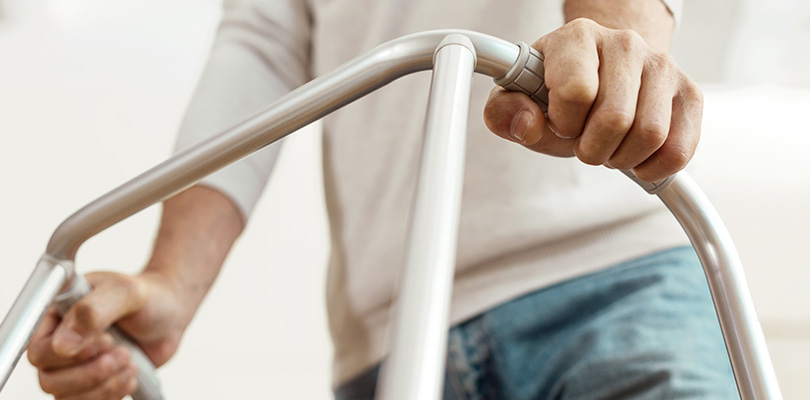Types of Mobility Aids
Mobility aids are devices that help an injured or disabled individual move from one place to another. Over the years, advances in science and technology have lead to an improvement in the design of disability devices and mobility aids, which make everyday tasks a little easier for disabled individuals.
Various mobility aids exist in the marketplace including crutches, canes, walkers, rollators, scooters, and wheelchairs. Choosing the right device for your disability takes time and research. In this article, we’ll discuss some of the most common mobility devices that are available.
Mobility Scooters
Mobility scooters are similar to electric wheelchairs, but they’re designed and configured like a motorized scooter.
The mobility that these devices offer is useful for individuals that can stand, sit, and walk for a short distance without any support, even though they suffer from disabling medical conditions.
Portable Scooters (Travel Scooters)
These mobility scooters are compact and lightweight and are either foldable or easy to disassemble into smaller and more manageable components completely. While they are a great option for individuals that are looking for an easy scooter to transport, they are not ideal for use on rough terrain.
An added bonus is that these smaller scooters are priced very affordable, which makes them ideal for individuals looking for a budget-friendly option.
Heavy Duty Scooters
These mobility scooters are equipped with a reinforced suspension and have higher ground clearance; they also have bigger motors, wider bases, and larger tires compared to light duty scooters. Heavy-duty scooters can be used on rough terrains such as uneven surfaces, hills, and fields. These scooters are very durable and can accommodate individuals up to 550lbs.
Luxury Scooters
These mobility scooters offer a superior combination of performance, versatility, and style to give the user a smooth, comfortable, and luxurious ride. While the price point is higher, they are extremely durable, and it’s unlikely that the individual with encounter any issues using the scooter on the surfaces that they encounter in everyday life.
Scooter Accessories
The accessory options for mobility scooters are endless – adding them to a mobility scooter adds protection, safety, and convenience. Some common storage options include rear and front baskets, storage compartments, armrest and seatback bags, and trailers.
For added safety, common options include rearview mirrors, canopies, and safety gear. To keep the individual's hands-free to operate the scooter, drink and phone holders, as well as oxygen tank and walking aid holders, are available.
Mobility Aids
Mobility aids consist of a variety of options that allow an individual to move easier and decrease the risk of injury and falls.
Almost 30% of Americans have high blood pressure but don’t know it. Some simple lifestyle changes can help you lower your blood pressure naturally.
Canes
Canes are used on the strong side of an individual’s body and move with the weak side to provide additional support and balance while an individual walks by widening the base of support and decreasing the weight that is placed on the joints of the lower body.
There are single tip canes that are quite easy to use and are recommended for individuals that need light support such as those with arthritis. Individuals with neurological impairment tend to do better with quad canes, which consist of four tips that provide an even bigger base of support.
Crutches
Crutches are one of the oldest mobility devices that are still commonly used today. Crutches help an injured individual transfer body weight from the legs to the upper body, thereby providing the legs with additional support and helping to maintain balance.
Walkers
Walkers consist of a lightweight frame with handlebars and four legs that can be easily folded for easy transport.
The front two legs may have wheels attached, with caster wheels or glides on the back legs. Additionally, some walkers are height adjustable.
Walkers are designed to provide additional support to disabled individuals and seniors, which help them maintain their balance and stability while walking.
Rollators (Wheeled Walker)
Rollators are similar to walkers except that they are made of a height-adjustable frame with three or four wheels, handlebars, and a seat.
If an individual has a disability that requires them to stop and sit to rest frequently, a rollator may be a better option compared to a walker, as they offer a seat. Because a rollator has three to four wheels, they are also equipped with handle brakes. Similar to walkers, some rollators can be folded easily for transport.
Typically rollators range in weight from 11 to 15lbs. Standard rollators have a weight capacity of up to 250lbs, while bariatric rollators have weight capacities between 350 and 500lbs. Some bariatric rollators have lower seats that make it easier for an individual to get in and out.
Wheelchairs
Wheelchairs have been designed to help individuals with injuries or disabilities that make walking difficult or impossible. Two types of wheelchairs are available in the marketplace – manual and electric.
Manual wheelchairs are either self-propelled using the arms, or companion-propelled, using the assistance of another individual. Electric wheelchairs, on the other hand, are battery operated and provide an individual with more independence and comfort.
Choosing a manual or electric wheelchair is dependent on the user’s functional ability and lifestyle.
Conclusion
If you suffer from a disability or injury that has lead to decreased mobility, utilizing a mobility aid may help you lead a more independent life and improve your quality of life.
The type of disability or injury that you have will determine the type of mobility aid that you need. Keep in mind that it’s absolutely crucial that the mobility aid that you select be correctly fitted for your body to improve comfort and function, and reduce your risk of injury.







